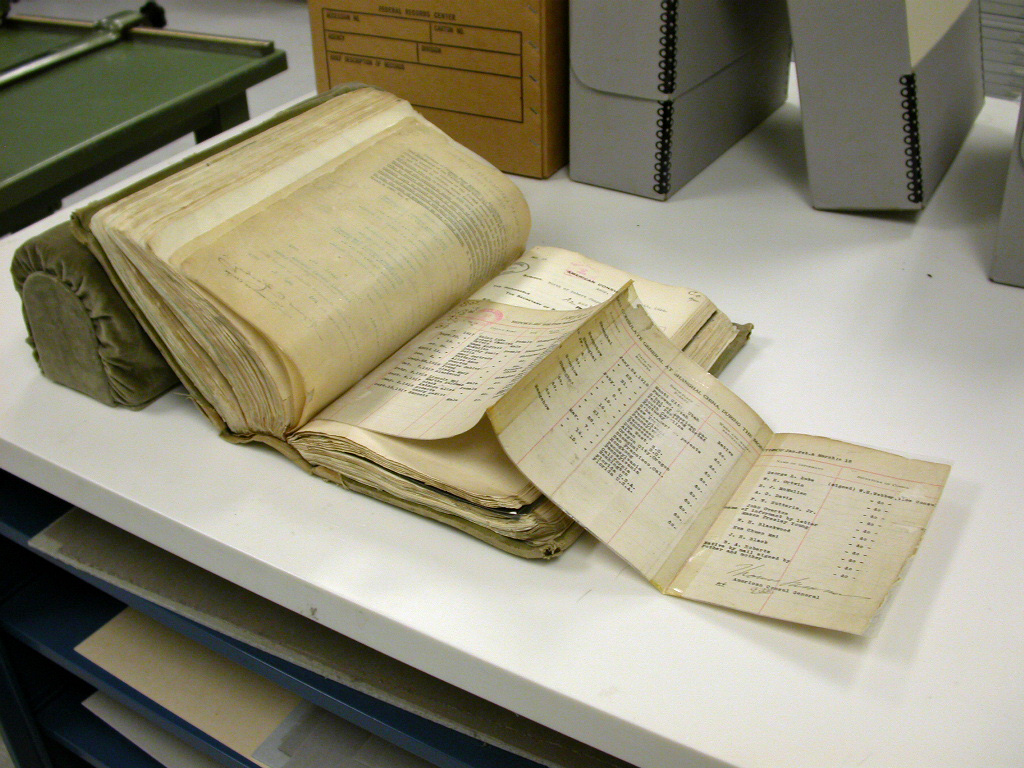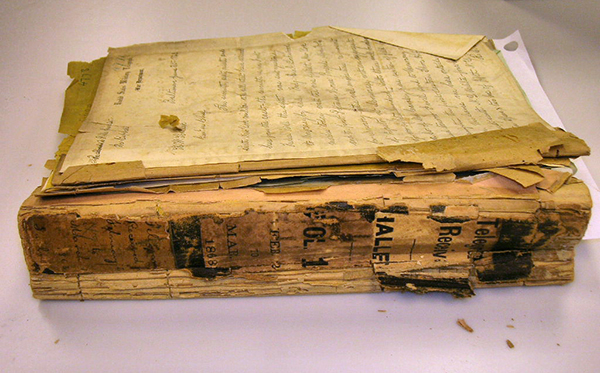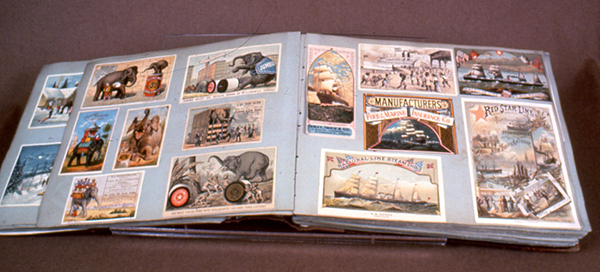
Bound Materials
In this section, information will be presented on:
Tying a Volume with Cotton Twill Tape
Bound Volumes
Support a volume to prevent damage to the binding and loose pages. Store a volume in good condition upright or flat on a shelf deep enough to support its entire surface. Use cotton tape ties to stabilize volumes with damaged bindings or detached boards, or provide a custom box for damaged volumes.
Before opening a volume remove any visible dust.
- Dust the covers with a soft, dry cloth or brush to remove surface dirt that could transfer to the pages during handling.
- Dust the text block edges with a soft brush while holding the covers tightly closed, making sure that the pages are held tightly together to avoid working dirt into the interior of the volume.
Avoid stressing the binding and covers whenever handing a bound volume.
- Never force a volume open beyond its natural flex.
- Prevent damage to the binding by supporting the weight of an opened cover and pages with a book cradle or a foam wedge.
Do not use adhesive labels to identify a bound volume. Write on the storage box whenever feasible or use an archival quality bookmark placed between the front cover and text block.
Gently align detached pages and loose text folios one at a time. Do not tap, fan or otherwise attempt to realign a group of pages. This causes damage, especially to brittle papers or edges that have been creased and folded back on themselves due to the overhang.
Non-record, loose, and acidic inserts such as place markers or cross-reference forms, left in bound volumes can stain and damage text pages.
- Evaluate any inserts to determine whether they are still pertinent. If they contain important archival information, reproduce them onto archival bond paper or hand-copy information onto archival bond paper or card stock.
- Consult with supervisors before removing, copying, or discarding any inserts or enclosures.
Do not place polyester L-sleeves, folders, envelopes, or other enclosures in bound volumes. The added thickness strains and damages the binding and the sharp edges of the sleeve can tear pages. If detached pages or associated insets need to be protected or retained, store them in an appropriate enclosure and keep next to the volume, in a box with the volume, or in another location following established procedure for cross-filing associated items.
Tie broken or weak bindings with white, flat, cotton twill tape to keep the covers and spine pieces from being separated from the text blocks. Tie the volume so that the bow or knot is recessed in the fore edge (opposite the spine) to avoid a bump that can rub against adjacent volumes.
Please review the following video, "Tying a Volume with Cotton Twill Tape" (no sound, with captions):
Protect a volume of high intrinsic value with detached boards or weakened bindings in a custom-made box, ideally stored flat.
- A custom box will provide greater protection than tying the boards.
- A variety of phased and drop-spine boxes can be constructed or purchased.
- If using a commercially available box, pad out any extra space with archival or mat board cut to size so the volume does not shift around in the box.
Conservation treatment to support a binding or reattach pages is recommended for a damaged volume of high intrinsic value or a volume that is not in usable condition.
Consult a conservator about laboratory treatment or custom housing for bound records.
Store most volumes vertically on shelves.
- Use bookends or spacer boards to prevent slumping.
- If the cover of the volume against the bookend is of high intrinsic value, consider placing a piece of archival mat board or corrugated board between the bookend and the volume to evenly distribute pressure along a larger area of the cover.
Shelve large or heavy volumes, especially if fragile or of high intrinsic value, flat to provide support for the text blocks and binding structures.
- Ensure the surface of the volume carrying the weight is fully supported on the shelf, using pieces of archival board if necessary to distribute weight.
- Avoid stacking oversize bound volumes more than three or four high.
Scrapbooks and Albums
Store scrapbooks and albums flat in boxes. A scrapbook or album is often too bulky to close tightly. A custom box protects the contents from dust and light and prevents loose items from falling out and becoming damaged or lost.
Store a scrapbook or album flat, whether it is in a box or not.
The materials used to create scrapbooks and photo albums can be inherently problematic for long-term preservation.
- Ties, ribbons, post rings, ring binders, and similar binding methods typically used to create albums and scrapbooks are structurally weak; pages often become detached over time.
- The pages themselves are often made from very acidic papers that become so brittle over time that the pages tear and break.
- Tape and other adhesive methods used to attach contents degrade over time, deteriorating the items and failing, so contents become loose and dissociated from their original placement.
- The tacky adhesive used in self-stick “magnetic” style pages deteriorates, rapidly staining contents and adhering them more permanently to the page.
Even though an album or scrapbook may be inherently unstable, it is better to leave papers, photographs and other records in place than to tear an item or damage the emulsion in an attempt to remove them.
- Removing records from an album page without damaging the items can be difficult. If a conservator is not available for assistance, leave the contents in place and house the album flat in a box.
When handling a scrapbook or album, support it fully as if it was a bound volume and turn the pages with care. Areas where a page attaches to the covers is often weak, and items may be loose on the reverse of the page.
Items may have become detached or may have been inserted between pages.
- Do not re-adhere loose items. Never use glue, glue sticks, pressure sensitive tapes, mounting corners, or any other adhesive or fastener.
- Place detached items in polyester sleeves in their original location in the scrapbook or album, if adding the sleeves does not stress and cause damage to the binding.
- If sleeves cannot be inserted safely, store loose items with their associated contents. Place them in appropriate enclosures inside the same box as the scrapbook or album or in another location following established procedure for cross-filing associated items.
- Talk to a conservator about reattaching detached items or treating individual items found in a scrapbook.


